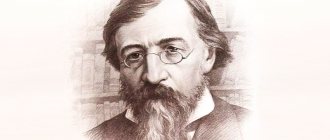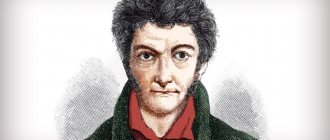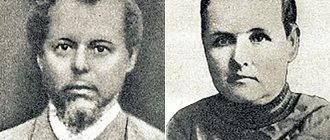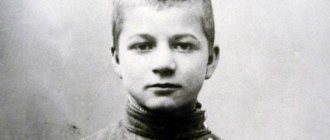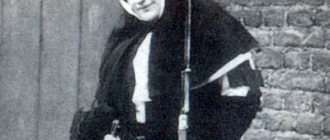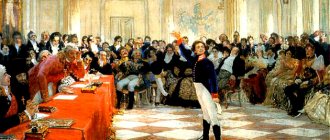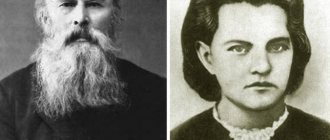Sergei Alexandrovich Yesenin is a subtle lyricist and dreamer, deeply in love with Rus'. He was born on September 21, 1895 in the village of Konstantinovo, Ryazan province. The poet's peasant family was very poor, and when Seryozha was 2 years old, his father went to work. The mother could not stand the absence of her husband, and soon the family fell apart. Little Seryozha went to be raised by his maternal grandfather.
Yesenin wrote his first poem at the age of 9. His short life lasted only 30 years, but was so eventful that it had a great influence on Russian history and the soul of every person. Hundreds of small poems and voluminous poems of the great poet echo throughout the vast country and beyond.
Creative path
Yesenin's first poems were published in Mirka, a magazine for children (1914). The very next year he travels from Moscow to Petrograd, where Yesenin recites his works before A.A. Blok, S.M. Gorodekim and others. In 1916, the poet was drafted into the war. Thanks to his friends, he ends up on the Tsarskoye Selo military ambulance train. But Sergei’s creative path did not stop there: his first collections were published, for example “Radunitsa”. The poet also becomes close to the group of “new peasant poets”, who subsequently played an important role.
His creative work continues among the Imagists in the 1918-1920s. These include such works as the collections “Confession of a Hooligan”, “Poems of a Brawler”, “Moscow Tavern”, as well as the well-known poem “Pugachev”.
During his short life (30 years), Sergei Yesenin managed to see Central Asia, visit the Urals and Orenburg region together with his friend Yakov Blumkin. In Tashkent, in addition to walking around the city, he becomes a participant in poetry evenings.
The poet devoted more than a year to traveling to Europe (Germany, France, Belgium, Italy) and to the USA together with his newlywed, Isadora Duncan. Upon Yesenin’s arrival, the Izvestia newspaper published his notes about America under the title “Iron Mirgorod”. In the 1920s he ran a bookshop on Bolshaya Nikitskaya.
Life story of Sergei Yesenin (32 photos)
Author: anthrax
03 October 2021 13:02
Community: Stars and celebrities: stories, photos, sensations
Tags: USSR Yesenin history facts
15419
32
On October 3, 1895, in the village of Konstantinov, Ryazan province, the future great poet Sergei Yesenin was born into a peasant family.
0
See all photos in the gallery
0
In January 1924, the poet Sergei Yesenin was discharged from a sanatorium for nervous patients, releasing him to say goodbye to the deceased leader of the revolution, Vladimir Ilyich Lenin. Shortly before Yesenin’s discharge, the poet Rurik Ivnev visited Yesenin, who described his comrade’s painful condition this way: “He spoke in a half-whisper, looked around, then began to get nervous, said that he needed to move away from the window, because they were watching him, they would see him and throw a stone at him.” Memoirs of friends and contemporaries of that period describe a disorder that in psychiatry is called delusions of persecution.
0
The personality of the great Russian poet Sergei Aleksandrovich Yesenin is complex and multifaceted, and memories of him are contradictory, but researchers and admirers of the poet’s work agree that he was extremely talented and loved Russia to the point of oblivion.
0
Be that as it may, the magnificent creative legacy that Sergei Yesenin left includes not only poems about the beauties of Russian nature, well known to us from the school curriculum, but also dramatic cycles telling about the mental torment of the poet, who suffered, according to experts, severe alcohol dependence. The consequences of alcohol abuse were attacks of melancholy and unmotivated aggression, delusions of persecution with visual and auditory hallucinations, painful insomnia, severe remorse and suicidal thoughts.
0
Already in adolescence, Yesenin began to manifest seemingly unjustified short temper, anger and conflict. The future poet did not tolerate contradictions and superiority over himself, no matter how it was expressed. Anger, according to the recollections of Yesenin’s sisters, flared up in him suddenly and disappeared just as suddenly. He assessed people by their attitude towards each other and divided them into good and evil, selfless and greedy, truthful and deceitful.
0
Yesenin made his first suicide attempt, which we learn about from the poet’s letter sent to his school friend Grisha Panfilov, at the age of 17: “I couldn’t stand the fact that empty tongues were chattering about me, and drank some essence. I lost my breath and for some reason began to foam. I was conscious, but everything in front of me was obscured by some kind of cloudy haze.” Yesenin took this decisive step some time after he moved out from his father in the hope of making his way into a literary future without outside help, but a collision with harsh reality, life from hand to mouth and the need to take care of his daily bread led the young man to despair. (In the photo: Grigory Panfilov - left and Sergei Yesenin - right.)
0
Finally, in March 1913, Yesenin found work in the Moscow printing house of I.D. Sytin on Pyatnitskaya Street, but the money he earns is only enough to feed himself and buy books, and his life continues to remain unsettled. The young man's restless character and anger did not contribute to his rapprochement with the printing house workers. He shares his thoughts only with his friend Grisha Panfilov: “How ridiculous our life is. She distorts us from the cradle and instead of true people some freaks come out. Here they consider me crazy, and they were about to take me to a psychiatrist, but I sent everyone to Satan and live, although some are afraid of my approach. Yes, Grisha, love and have pity on people. Love the oppressors and do not stigmatize them.”
0
The motive of his own early death is often heard in the poet’s poems written in different years. “I meet everything, I accept everything, I’m glad and happy to take out my soul. I came to this earth to quickly leave it” (1914). “I see myself deceased in a coffin under the hallelujah lamentations of the sexton, I lower my dead eyelids lower, placing two copper spots on them...” (1924).
0
Sergei Yesenin met the American dancer Isadora Duncan in 1921. Isadora was 17 years older than the poet, she doted on her young lover, wrote “I love Yesenin” on the mirror with lipstick, gave him expensive gifts and could not refuse him anything.
0
Isadora Duncan’s affection for Sergei Yesenin is often explained by the poet’s resemblance to the son of a dancer who tragically died in childhood. Yesenin and Duncan got married in May 1922, then Isadora was going on a tour abroad, and Sergei would not have been given a visa if he had not been married to her. On May 10, 1922, the couple flew from Moscow to Kaliningrad, and from there to Berlin.
0
Soon after arriving in Germany, Isadora Duncan began touring around the country, on which she was accompanied by Sergei Yesenin, who had now lost the opportunity to devote all his time to writing poetry. The constant internal struggle between the desire for creative work and the limited ability to do this undermined his nervous system and caused mental suffering. He tried to fill the resulting void with expensive suits and shoes, which Duncan sewed with his money, and poured alcohol on him.
0
One of the doctors drew Isadora Duncan’s attention to the poet’s unhealthy appearance: a pale face, bags under the eyes, puffiness, cough, hoarse voice - and warned that he needed to immediately stop drinking alcohol, which even in small doses has a detrimental effect, “otherwise you will suffer.” there will be a maniac in our care.” Drunk Yesenin was prone to attacks of unmotivated aggression, primarily against Isadora, but he often got it on those around him.
0
No matter how hard Isadora Duncan tried to convince the reading public in Europe and America that Sergei Yesenin was a brilliant Russian poet, he was perceived only as the young wife of a famous dancer, they admired his elegance and physical form, and predicted a sports career. “I pray to God not to die in soul and not to lose love for my art. Nobody needs it here,” Yesenin wrote to his friend Anatoly Mariengof.
0
After a long stay abroad, Sergei Yesenin and Isadora Duncan returned to Moscow and soon separated. When meeting with her translator Ilya Shneider, Isadora said: “I took this child from Russia, where living conditions were difficult. I wanted to save it for the world. Now he has returned to his homeland to save his mind, since he cannot live without Russia.”
0
Living in Moscow, Yesenin wrote poetry almost every day, but this did not stop him from meeting his former friends, who spent a lot of time in restaurants, where they drank and ate at Sergei Alexandrovich’s expense. The poet Vsevolod Rozhdestvensky recalled how Yesenin changed after returning to Russia: “The face is swollen, the eyes are dull and sad, heavy eyelids and two deep folds near the mouth. The expression of deep weariness did not leave him, even when he laughed. My hands were shaking noticeably. Everything about him testified to some kind of internal confusion.” At the same time, Rozhdestvensky drew attention to how quickly Sergei Yesenin moved from explosions of joy to the darkest melancholy, how unusually closed and distrustful he was.
0
The poet increasingly found himself in scandalous stories, became the initiator of fights, and insulted others. After one of these scandals, Yesenin was sent to a sanatorium for nervous patients, from where he was discharged in January 1924 to say goodbye to the deceased leader of the revolution, Vladimir Ilyich Lenin.
0
After his discharge, rumors began to circulate in Moscow about the poet’s eccentricities; perhaps they were somewhat exaggerated by the press. As if in one cafe he wanted to hit someone with a chair, attacked the doorman, whose behavior seemed suspicious, and in another place “threw a plate of vinaigrette at a visitor.” However, people close to Sergei Yesenin unanimously began to say that the poet was suffering from a mental disorder.
0
Memoirs of friends and contemporaries of that period describe a disorder that in psychiatry is called delusions of persecution. From the memoirs of Ilya Erenburg: “Yesenin could not find a place for himself anywhere, he suspected even his friends of intrigues, and believed that he would soon die.” The editor of the Krasnaya Nov magazine, Alexander Voronsky, wrote: “Yesenin said that he has many enemies who are conspiring against him and are going to kill him.” One day, sitting in Voronsky’s office, the poet became worried, “opened the door and, seeing the guard on duty, began to strangle him,” mistaking him for a murderer. Voronsky was sure that at that moment Sergei Yesenin was hallucinating.
0
Yesenin told his friends that he was once attacked by bats in a hotel: “The gray cemetery freaks kept me awake all night.” According to him, “they flew into the window: first one hung on the bed, I hit him with my hand, and he sat on the closet. When I turned on the light, I saw that his claws were red, as if manicured, and his mouth was a blood-red stripe.”
0
In March 1925, Sergei Yesenin met Sofia Andreevna Tolstoy, the granddaughter of Lev Nikolaevich Tolstoy. Sofya Andreevna was delighted with Yesenin’s courtship, she was ready to become an assistant and friend for him, which she declared to her relatives, who reacted negatively to her choice, knowing about the groom’s penchant for abusing alcohol and his restless character. Friends noticed that Yesenin had changed with Tolstoy; he was often seen walking around Moscow on her arm, always sober, in an elegant suit. It seemed to those around him that a strong and fruitful life would begin for him, but this was not destined to happen. In September 1925, Sergei Yesenin married Sofya Tolstoy and moved into her apartment. The poet told his friends that the bulky furniture in his apartment irritated him and that he was “overcome by his beard,” i.e. portraits of Leo Tolstoy on the walls and tables, at which Yesenin tried to throw something heavy. He began inviting friends to his apartment, having drinking bouts, or going to see them and invariably returning drunk.
0
One day Yesenin threw his bust by the sculptor Konenkov from the balcony of the Tolstoys’ apartment, declaring that “Seryozha is hot and stuffy.” The bust fell into pieces. Sofia Tolstoy’s mother later told her friend: “Some types lived with us, they were hooligans and drunkards, they slept in our beds. They ate and drank with Yesenin’s money, but Sonya had no shoes. But you can't blame him. He is a sick man. I feel sorry for Sonya."
0
In November 1925, Yesenin went to Leningrad to visit friends and stayed with the writer Sakharov. From Sakharov’s memoirs it is known that at night he felt that someone was strangling him, turned on the light and saw Yesenin, he looked scared. Sakharov managed to calm the poet down and put him to bed, but in the morning there was the sound of broken glass. Sakharov saw Yesenin standing in the middle of the room in tears, covered in shrapnel. The writer realized that Sergei had suffered another attack of illness, sent him to Moscow and advised his family to show him to the doctors.
0
On November 26, 1925, Sergei Yesenin was hospitalized at the Psychiatric Clinic of Moscow University, which at that time was headed by Professor Pyotr Borisovich Gannushkin, well-known in the medical world.
0
At the clinic, Yesenin was allocated a separate room on the second floor. The atmosphere here was comfortable, close to home, there were carpets and carpet runners everywhere, soft sofas and armchairs, and paintings hanging on the walls. While in a psychiatric hospital, Sergei Yesenin did not stop writing poetry. On the third day of his stay in the clinic, from the window he saw a maple covered with snow, on the same day a famous poem was born: “You are my fallen maple, you are an icy maple, why are you standing bent over under the white blizzard?”
0
Despite the seemingly comfortable living conditions, Yesenin was irritated by everything: the constantly open door of the hospital room, into which curious patients looked, and the light of a night lamp that never turned off, and walks accompanied by staff (the poet was under constant supervision for the reason suicidal thoughts).
0
On December 20, 1925, Yesenin was visited in the hospital by Anna Abramovna Berzin, who later wrote in her memoirs about this visit: “The poet’s attending physician - a kind and gentle person - warned me not to give Yesenin piercing, cutting objects, as well as ropes and laces, so that the patient cannot use them for suicidal purposes. He explained that the illness was serious and there was no hope of recovery and that he would live no more than a year.”
0
Yesenin refused to meet with his wife Sofia Andreevna, considering her to be the initiator of his placement in the clinic. And on December 21, 1925, the poet was not found in the ward. After a meeting with some friends who brought with them a winter coat, hat and shoes, Yesenin changed clothes and, under the guise of a visitor, walked past the guards. The clinic took measures to search for the fugitive, they searched everywhere, the attending physician Aranson called the poet’s relatives and friends, and went home to those who did not have a telephone. Three days after escaping from the hospital, Yesenin showed up at the Tolstoys’ apartment, the family breathed a sigh of relief, but the joy was short-lived. Without saying hello, without saying a word, the poet began feverishly packing his things, and when the suitcases were ready, he went out without saying goodbye and slammed the door. From Moscow, Sergei Yesenin fled to Leningrad, where he arrived on December 24, 1925.
0
Upon arrival in Leningrad, the poet rented a room on the second floor of the Angleterre Hotel. In the evening, some literary acquaintances visited him and reminisced about the past. Yesenin read the poem “The Black Man” in its finished form: “My friend, my friend, I am very, very sick, I don’t know where this pain came from, either the wind whistles over an empty and deserted field, or like a grove in September , showers your brain with alcohol..."
0
The next day, December 25, Sergei Yesenin asked the poet Erlich to stay overnight with him, as is known from the latter’s memoirs. Ehrlich wrote that Yesenin experienced fears, was afraid to remain alone in the room, explained that they wanted to kill him, and warned the guard on duty that no one would be allowed to see him without permission. (In the photo - Wolf Ehrlich.)
0
From the investigation documents it is known that on December 27 Yesenin again had many guests. The poet treated everyone to wine and read “The Black Man” again, then tore the scribbled sheet out of the notebook and put it in the poet Erlich’s inner pocket, telling him to read it later. Yesenin explained that he wrote this poem in blood this morning, “since there is not even ink in this lousy hotel,” and showed the cuts on his hand from which he took the blood. Erlich did not imagine that he would see Yesenin alive for the last time.
0
Yesenin's body was discovered on December 28, 1925. From the testimony of the commandant of the Angleterre Hotel Nazarov: “...citizen Ustinova and with her citizen Erlich caught up with me and, clutching my head, in horror asked me to return to room 5. I entered and saw Yesenin hanging on a rope from a steam heating pipe.” (Photograph of room No. 5, taken after the discovery of the poet’s body.)
0
Sergei Yesenin was buried on December 31, 1925 in Moscow at the Vagankovskoye cemetery.
Source:
More cool stories!
- Tattoos with a story behind each one
- How did they deal with aging slaves in ancient times?
- Popular professions that disappeared thanks to the advent of machines
- The strangest and most unusual wills
subscribe to the community “Stars and Celebrities: Stories, Photos, Sensations”
Tags: USSR Yesenin history facts
Do you like to remember how things were before? Join us, let's feel nostalgic together:
117 1 116
Liked
116 3
38
Partner news
Personal life
The poet's first serious love was Zinaida Reich, the secretary of the editorial office of the newspaper Delo Naroda. They had a complex relationship. Sergei had bad habits: drinking, women, hooliganism, which caused conflicts with his wife. Subsequently, two children remained from their marriage - Tanechka and Kostya, who were adopted by Vsevolod Meyerhold, her husband. But all her life she continued to love only one Sergei. At the literary evening “The Trial of the Imagists,” the ardent poet meets Galina Benislavskaya. They soon become very close. But after some time, Sergei’s head was turned by Isadora Duncan, with whom he went abroad. But after 1.5 years, having returned to his homeland, he returns to Benislavskaya. However, he saw her exclusively as a friend, even though Galina loved him immensely. But in 1925 he married Sonechka Tolstoy.
Near the grave of Sergei Yesenin, Galina committed suicide. “Faithful Galina,” they wrote on the monument, burying her next to her beloved.
Childhood and early years
The great Russian poet was born into a family of simple peasants on October 3, 1895.
Place of birth: the village of Konstantinovo, Ryazan province. He had two younger sisters - Alexandra and Ekaterina.
At the age of 9, Sergei was sent to the Konstantinovsky Zemstvo School, and 5 years later he went to a parochial school. After its graduation, 17-year-old Yesenin left to conquer the capital. At first he worked in a butcher shop, then found a place in the printing house of the book publisher Sytin.
In 1913, the young man entered Shanyavsky University in the historical and philosophical department. He continued his activities in the printing house and struck up friendly relations with the poets of the Surikov musical circle.
Nadya Volpin - Yesenin’s mistress and a smart girl who has ceased to be hope
In 1920, at one of the poetry evenings, Sergei met the aspiring poetess Nadezhda Volpin.
Nadezhda Volpin
A well-educated girl knew six languages and wrote quite good poetry. At this time, Sergei had not yet filed for divorce from Reich, he lives with Galya Benislavskaya, but persistently seeks intimacy with Nadya. When his next book of poems comes out, he gives it with an ambiguous inscription: “To Nadezhda Volpin with the hope that she will no longer be a hope.”
For more than a year, their relationship did not go beyond friendship, but when Sergei achieved what he wanted, he was very surprised that he became her first man. And... I was afraid of responsibility. At the same time, his relationship with Benislavskaya develops, and a little later Isadora Duncan appears.
When Nadezhda said that there would be a child, Sergei protested, saying that he already had children. Volpin was a smart woman; she realized that it would not be possible to build a full-fledged family with a flighty poet. She is leaving for St. Petersburg; Yesenin has not seen her son Alexander.
